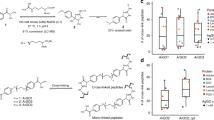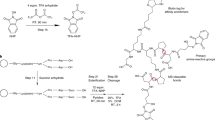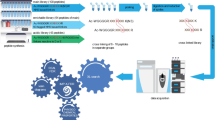Abstract
Chemical cross-linking in combination with LC-MS/MS (XL-MS) is an emerging technology to obtain low-resolution structural (distance) restraints of proteins and protein complexes. These restraints can also be used to characterize protein complexes by integrative modeling of the XL-MS data, either in combination with other types of structural information or by themselves, to establish spatial relationships of subunits in protein complexes. Here we present a protocol that has been successfully used to generate XL-MS data from a multitude of native proteins and protein complexes. It includes the experimental steps for performing the cross-linking reaction using disuccinimidyl suberate (a homobifunctional, lysine-reactive cross-linking reagent), the enrichment of cross-linked peptides by peptide size-exclusion chromatography (SEC; to remove smaller, non-cross-linked peptides), instructions for tandem MS analysis and the analysis of MS data via the open-source computational software pipeline xQuest and xProphet (available from http://proteomics.ethz.ch). Once established, this robust protocol should take ∼4 d to complete, and it is generally applicable to purified proteins and protein complexes.
This is a preview of subscription content, access via your institution
Access options
Subscribe to this journal
Receive 12 print issues and online access
$259.00 per year
only $21.58 per issue
Buy this article
- Purchase on Springer Link
- Instant access to full article PDF
Prices may be subject to local taxes which are calculated during checkout




Similar content being viewed by others
References
Benesch, J.L.P. & Ruotolo, B.T. Mass spectrometry: come of age for structural and dynamical biology. Curr. Opin. Struct. Biol. 21, 641–649 (2011).
Stengel, F., Aebersold, R. & Robinson, C.V. Joining forces: integrating proteomics and cross-linking with the mass spectrometry of intact complexes. Mol. Cell. Proteomics 11, R111.014027 (2012).
Hilton, G.R. & Benesch, J.L.P. Two decades of studying non-covalent biomolecular assemblies by means of electrospray ionization mass spectrometry. J. Royal Soc. Interf. 9, 801–816 (2012).
Walzthoeni, T., Leitner, A., Stengel, F. & Aebersold, R. Mass spectrometry supported determination of protein complex structure. Curr. Opin. Struct. Biol. 23, 252–260 (2013).
Leitner, A. et al. Probing native protein structures by chemical cross-linking, mass spectrometry, and bioinformatics. Mol. Cell. Proteomics 9, 1634–1649 (2010).
Petrotchenko, E.V. & Borchers, C.H. Crosslinking combined with mass spectrometry for structural proteomics. Mass Spectrom. Rev. 29, 862–876 (2010).
Rappsilber, J. The beginning of a beautiful friendship: cross-linking/mass spectrometry and modelling of proteins and multi-protein complexes. J. Struct. Biol. 173, 530–540 (2011).
Konermann, L., Pan, J. & Liu, Y.H. Hydrogen exchange mass spectrometry for studying protein structure and dynamics. Chem. Soc. Rev. 40, 1224–1234 (2011).
Konermann, L., Stocks, B.B., Pan, Y. & Tong, X. Mass spectrometry combined with oxidative labeling for exploring protein structure and folding. Mass Spectrom. Rev. 29, 651–667 (2010).
Tang, X. & Bruce, J.E. A new cross-linking strategy: protein interaction reporter (PIR) technology for protein-protein interaction studies. Mol. Biosyst. 6, 939–947 (2010).
Kao, A. et al. Development of a novel cross-linking strategy for fast and accurate identification of cross-linked peptides of protein complexes. Mol. Cell. Proteomics 10, M110.002212 (2011).
Petrotchenko, E.V., Serpa, J.J. & Borchers, C.H. An isotopically coded CID-cleavable biotinylated cross-linker for structural proteomics. Mol. Cell. Proteomics 10, M110.001420 (2011).
Zheng, X. et al. Cross-linking measurements of in vivo protein complex topologies. Mol. Cell. Proteomics 10, M110.006841 (2012).
Hoopman, M.R., Weisbrod, C.R. & Bruce, J.E. Improved strategies for rapid identification of chemically cross-linked peptides using protein interaction reporter technology. J. Proteome Res. 9, 6232–6333 (2010).
Petrotchenko, E.V. & Borchers, C.H. ICC-CLASS: isotopically-coded cleavable crosslinking analysis software suite. BMC Bioinform. 11, 64 (2010).
Rasmussen, M.I., Refsgaard, J.C., Peng, L., Houen, G. & Hojrup, P. CrossWork: software-assisted identification of cross-linked peptides. J. Proteomics 74, 1871–1883 (2011).
Goetze, M. et al. StavroX-A software for analyzing crosslinked products in protein interaction studies. J. Am. Soc. Mass Spectrom. 23, 76–87 (2012).
Bing, Y. et al. Identification of cross-linked peptides from complex samples. Nat. Methods 9, 904–906 (2012).
Müller, D.R. et al. Isotope tagged cross linking reagents. A new tool in mass spectrometric protein interaction analysis. Anal. Chem. 73, 1927–1934 (2001).
Seebacher, J. et al. Protein cross-linking analysis using mass spectrometry, isotope-coded cross-linkers, and integrated computational data processing. J. Proteome Res. 5, 2270–2282 (2006).
Russel, D. et al. Putting the pieces together: integrative modeling platform software for structure determination of macromolecular assemblies. PLoS Biol. 10, e1001244 (2012).
Ward, A.B., Sali, A. & Wilson, I. A. Integrative Structural Biology. Science 339, 913–915 (2013).
Schneidman-Duhovny, D. et al. A method for integrative structure determination of protein-protein complexes. Bioinformatics 28, 3282–3289 (2012).
Leitner, A. et al. Expanding the chemical cross-linking toolbox by the use of multiple proteases and enrichment by size exclusion chromatography. Mol. Cell. Proteomics 11, M111.014126 (2012).
Rinner, O. et al. Identification of cross-linked peptides from large sequence databases. Nat. Methods 5, 315–318 (2008).
Walzthoeni, T. et al. False discovery rate estimation for cross-linked peptides identified by mass spectrometry. Nat. Methods 9, 901–903 (2012).
Bohn, S. et al. Structure of the 26S proteasome from Schizosaccharomyces pombe at subnanometer resolution. Proc. Natl. Acad. Sci. USA 107, 20992–20997 (2010).
Lasker, K. et al. Molecular architecture of the 26S proteasome holocomplex determined by an integrative approach. Proc. Natl. Acad. Sci. USA 109, 1380–1387 (2012).
Blattner, C. et al. Molecular basis of Rrn3-regulated RNA polymerase I initiation and cell growth. Genes Dev. 25, 2093–2105 (2011).
Jennebach, S. et al. Crosslinking-MS analysis reveals RNA polymerase I domain architecture and basis of rRNA cleavage. Nucl. Acids. Res. 40, 5591–5601 (2012).
Wu, C.-C. et al. RNA polymerase III subunit architecture and implications for open promoter complex formation. Proc. Natl. Acad. Sci. USA 109, 19232–19237 (2012).
Leitner, A. et al. The molecular architecture of the eukaryotic chaperonin TRiC/CCT. Structure 20, 814–825 (2012).
Ciferri, C. et al. Molecular architecture of human polycomb repressive complex 2. eLife 1, e00005 (2012).
Tosi, A. et al. Structure and subunit topology of the INO80 chromatin remodeler and its nucleosome complex. Cell 154, 1207–1219 (2013).
Nguyen, V.Q. et al. Molecular architecture of the ATP-dependent chromatin-remodeling complex SWR1. Cell 154, 1220–1231 (2013).
Kalisman, N., Adams, C.M. & Levitt, M. Subunit order of eukaryotic TRiC/CCT chaperonin by cross-linking, mass spectrometry, and combinatorial homology modeling. Proc. Natl. Acad. Sci. USA 109, 2884–2889 (2012).
Kalisman, N., Schroeder, G.F. & Levitt, M. The crystal structures of the eukaryotic chaperonin CCT reveal its functional partitioning. Structure 21, 540–549 (2013).
Herzog, F. et al. Structural probing of a protein phosphatase 2A network by chemical cross-linking and mass spectrometry. Science 337, 1348–1352 (2012).
Schraidt, O. et al. Topology and organization of the Salmonella typhimurium type III secretion needle complex components. PLoS Pathog. 6, e1000824 (2010).
Pang, S.S. et al. The structural basis for autonomous dimerization of the pre-T-cell antigen receptor. Nature 467, 844–848 (2010).
Lauber, M.A. & Reilly, J.P. Structural analysis of a prokaryotic ribosome using a novel amidinating cross-linker and mass spectrometry. J. Proteome Res. 10, 3604–3616 (2011).
Thierbach, K. et al. Protein interfaces of the conserved Nup84 complex from Chaetomium thermophilum shown by crosslinking mass spectrometry and electron microscopy. Structure 21, 1672–1682 (2013).
Buey, R.M. et al. Insights into EB1 structure and the role of its C-terminal domain for discriminating microtubule tips from the lattice. Mol. Biol. Cell 22, 2912–2923 (2011).
Kisko, K. et al. Structural analysis of vascular endothelial growth factor receptor-2/ligand complexes by small-angle X-ray solution scattering. FASEB J. 25, 2980–2986 (2011).
Weisbrod, C.R. et al. In vivo protein interaction network identified with a novel real-time cross-linked peptide identification strategy. J. Proteome Res. 12, 1569–1579 (2013).
Chavez, J.D., Weisbrod, C.R., Zheng, C., Eng, J.K. & Bruce, J.E. Protein interactions, post-translational modifications and topologies in human cells. Mol. Cell. Proteomics 12, 1451–1467 (2013).
Elias, J.E. & Gygi, S.P. Target-decoy search strategy for increased confidence in large-scale protein identifications by mass spectrometry. Nat. Methods 4, 207–214 (2007).
Käll, L., Storey, J.D., MacCoss, M.J. & Noble, W.S. Assigning significance to peptides identified by tandem mass spectrometry using decoy databases. J. Proteome Res. 7, 29–34 (2008).
Chambers, M.C. et al. A cross-platform toolkit for mass spectrometry and proteomics. Nat. Biotechnol. 30, 918–920 (2012).
Chen, Z.A. et al. Architecture of the RNA polymerase II-TFIIF complex revealed by cross-linking and mass spectrometry. EMBO J. 29, 717–726 (2010).
Acknowledgements
We thank M. Bonvin, M. Faini and F. Stengel for critical reading of the manuscript. This work was supported by the European Union 7th Framework project PROSPECTS (Proteomics Specification in Space and Time, grant no. HEALTH-F4-2008-201648) and by the European Research Council Advanced Grant Proteomics v3.0 (grant no. 233226) of the European Union to R.A.
Author information
Authors and Affiliations
Contributions
A.L., T.W. and R.A. designed research. A.L. and T.W. performed the experiments and analyzed the data. A.L., T.W. and R.A. wrote and edited the manuscript.
Corresponding authors
Ethics declarations
Competing interests
The authors declare no competing financial interests.
Integrated supplementary information
Supplementary Figure 1 xQuest/xProphet results manager.
The results manager is used as the central program for organizing and exploring xQuest/xProphet search results. Detailed documentation can be found following the link “How to use” (A). Different options are available to display and organize the individual search results (B). Individual experiments and definition files can be accessed from the table that displays the experiments (C). Experiments can be explored in the results viewer by clicking on “view” (D and Supplementary Figure 2).
Supplementary Figure 2 xQuest/xProphet results viewer.
Multiple filter and export options are available in the upper menu panel of the results viewer (A). If an xProphet analysis was performed, the filters that were used for the analysis are automatically loaded. Search results of the individual spectra are displayed in the table (B). For further inspection of the search results the “view” link can be used to open the spectrum viewer and display the spectrum of the identification (C and Supplementary Figure 3).
Supplementary Figure 3 xQuest spectrum viewer.
An example spectrum for a cross-linked peptide is depicted. Different filter options are displayed at the top of the window (A), which are initially loaded automatically from the xQuest definition file that was used for the search. The experimental spectrum (B) and the corresponding cross-link sequence (C) are shown below, whereby matched ions are indicated by diamonds in the spectrum, and as tick marks on the cross-link sequence. Spectrum (D) displays the matched ions that correspond to the individual peptides of a cross-link, indicated by the different colors, blue and yellow, for the alpha- and beta-peptide, respectively. (E) shows the table with the matched fragment-ion masses. Color coding in B and E: green indicates a common fragment ion, red indicates a cross-linker containing fragment ion.
Supplementary Figure 4 Example of an MS/MS spectrum from an mzXML file.
Tags and attributes used by the xQuest/xProphet pipeline are highlighted in yellow.
Supplementary Figure 5 Example of the LC-MS/MS analysis of two SEC fractions.
(A) and (B) show total ion chromatograms of fractions 1 and 2 highlighted in Figure 3b. Peptides from the higher molecular weight fraction 1 tend to be more hydrophobic so they elute slightly later under identical chromatographic conditions than peptides from fraction 2. (C) Two-dimensional plot (mass-to-charge vs. retention time) of the run shown in B. Only a small retention time (20-30 min) and m/z window (700-1100) is shown for clarity. Signals highlighted by asterisks on their right side correspond to peptides carrying a cross-linker modification. The difference in m/z space is 12/z for DSS-d0/d12. Due to the slight change in hydrophobicity, peptides with the heavy version of the cross-linker elute slightly (typically a few seconds) before the light form. xQuest allows the definition of a time window that is considered for pairing MS/MS spectra for the light and heavy forms. Even in this small window, more than 30 high-abundant pairs are clearly visible, and many more low-abundance pairs exist.
Supplementary information
Supplementary Figure 1
xQuest/xProphet results manager.. (PDF 170 kb)
Supplementary Figure 2
xQuest/xProphet results viewer. (PDF 683 kb)
Supplementary Figure 3
xQuest spectrum viewer. (PDF 172 kb)
Supplementary Figure 4
Example of an MS/MS spectrum from an mzXML file. (PDF 84 kb)
Supplementary Figure 5
Example of the LC-MS/MS analysis of two SEC fractions. (PDF 126 kb)
Supplementary Manual
User manual for the xQuest/xProphet virtual machine. (PDF 378 kb)
Rights and permissions
About this article
Cite this article
Leitner, A., Walzthoeni, T. & Aebersold, R. Lysine-specific chemical cross-linking of protein complexes and identification of cross-linking sites using LC-MS/MS and the xQuest/xProphet software pipeline. Nat Protoc 9, 120–137 (2014). https://doi.org/10.1038/nprot.2013.168
Published:
Issue Date:
DOI: https://doi.org/10.1038/nprot.2013.168
This article is cited by
-
Targeted cross-linker delivery for the in situ mapping of protein conformations and interactions in mitochondria
Nature Communications (2023)
-
FTD-tau S320F mutation stabilizes local structure and allosterically promotes amyloid motif-dependent aggregation
Nature Communications (2023)
-
Dual domain recognition determines SARS-CoV-2 PLpro selectivity for human ISG15 and K48-linked di-ubiquitin
Nature Communications (2023)
-
Structure of nascent 5S RNPs at the crossroad between ribosome assembly and MDM2–p53 pathways
Nature Structural & Molecular Biology (2023)
-
Replisome-cohesin interactions provided by the Tof1-Csm3 and Mrc1 cohesion establishment factors
Chromosoma (2023)
Comments
By submitting a comment you agree to abide by our Terms and Community Guidelines. If you find something abusive or that does not comply with our terms or guidelines please flag it as inappropriate.



